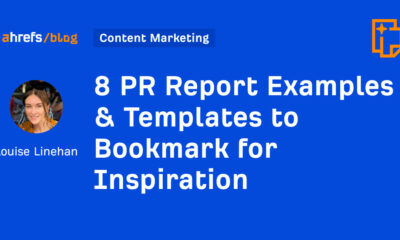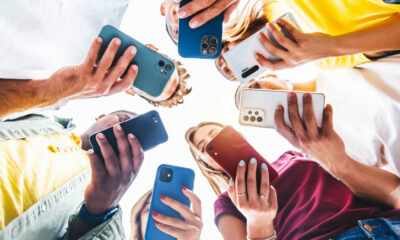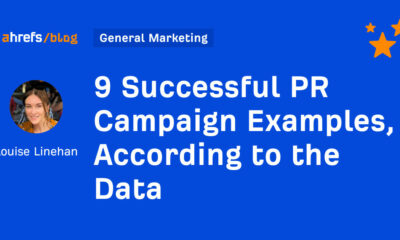SEO
8 Machine Learning Examples From Brands To Inspire Digital Marketers

Machine learning is all the rage but what does it actually look like in practice, as part of a digital marketing strategy?
You’ve encountered a machine learning strategy if you’ve used a website that recommends products based on previous purchases.
Machine learning is a facet of artificial intelligence (AI) that uses algorithms to complete specific tasks, such as product recommendations.
It can achieve a multitude of functions for digital marketers, including:
Machine learning has been in digital marketing for years.
In fact, you are using machine learning whenever you use search engines.
While still a new strategy for most, many businesses have begun implementing this technology into their marketing campaigns.
Below are eight examples of machine learning in digital marketing.
1. Chase
In 2019, the banking giant, Chase Bank, partnered with Persado to help create marketing copy for its campaigns.
They challenged the AI company to generate copy that yields more clicks — which they did.
Examples of the machine learning generated copy are:
Human copy: “Go paperless and earn $5 Cash Back.”
Machine-generated copy: “Limited Time Offer: We’ll reward you with $5 Cash Back when you go paperless.”
Results: AI copy generated nearly double the clicks.
Human copy: “Access cash from the equity in your home” with a “Take a look” button.
Machine-generated copy: “It’s true – You can unlock cash from the equity in your home” with a quick “Click To Apply.”
Results: AI copy attracted 47 applicants a week, while human copy attracted 25 applicants a week.
Human copy: “Hurry, It Ends December 31 Earn 5% Cash Back At Department Stores, Wholesale Clubs.”
Machine-generated copy: “Regarding Your Card: 5% Cash Back Is Waiting For You”
Results: AI copy generated nearly five times the unique clicks.
While the machine-generated copy may have performed better with customers, it’s important to remember that it worked with human copywriters feeding it ideas.
Together, human copywriters and machine learning can create and optimize copy that resonates.
2. Starbucks
With stores worldwide, Starbucks obtains a lot of data.
Starbucks can access purchase insights and turn this information into marketing collateral with the Starbucks loyalty card and mobile app. This strategy is called predictive analysis.
For example, machine learning collects the drinks each customer buys, where they buy them, and when they buy them, and matches this with outside data such as weather and promotions to serve ultra-personalized ads to customers.
One instance includes identifying the customer through Starbucks’ point-of-sale system and providing the barista with their preferred order.
The app can also suggest new products based on previous purchases (which can change according to weather conditions or holidays).
Machine learning can take the guesswork out of product recommendations.
Retail giants like Starbucks have millions of customers, yet they can make each feel like they get personalized recommendations because they can sift through data quickly and efficiently.
3. eBay
eBay has millions of email subscribers. Each email needed engaging subject lines that would cause the customer to click.
However, delivering over 100 million eye-catching subject lines proved overwhelming to human writers.
Enter machine learning.
eBay partnered with Phrasee to help generate engaging subject lines that didn’t trigger spam filters. Additionally, the machine-generated copy aligned with eBay’s brand voice.
Their results show success:
- 15.8% increase in open rates.
- 31.2% increase in average clicks.
- Over 700,000 incremental opens per campaign.
- Over 56,000 incremental clicks per campaign.
Machine learning can take the most daunting tasks and complete them within minutes at scale.
As a result, businesses can focus more on big-picture campaigns than microtasks.
4. Doordash
Doordash operates thousands of marketing campaigns across its marketing channels.
Their team manually updates bids based on the ads’ performance.
However, the team found that this task was time-consuming and overwhelming.
So Doordash turned to machine learning to optimize its marketing spend.
It built a marketing automation platform based on attribution data.
This data tells the company which channel the customer converted on and with what campaign.
However, it can be hard to promptly collect that type of data with thousands of campaigns going on at once.
Machine learning helps tackle this task by collecting that data and creating spending recommendations so they can optimize their budget quickly and efficiently.
5. Autodesk
Autodesk saw the need for more sophisticated chatbots.
Consumers are often frustrated by the limitations of chatbots and therefore prefer to speak with a human.
However, chatbots can help efficiently guide customers to the content, salesperson, or service page they need.
So Autodesk turned to machine learning and AI.
Autodesk’s chatbot uses machine learning to create dialogue based on search engine keywords.
Then, the chatbot can connect to the customer on the other end, allowing for faster conversion rates.
Since implementing their chatbot, Autodesk had three times the chat engagement and a 109% increase in time spent on the page.
6. Baidu
In 2017, Baidu, the Chinese search engine, built a system called Deep Voice that uses machine learning to convert text to speech. This system can learn 2,500 voices with a half-hour of data each.
Baidu explains that Deep Voice can lead to more immersive experiences in video games and audiobooks.
Baidu’s goal with Deep Voice is to teach machines to speak more human-like by imitating thousands of human voices.
Soon, the search engine hopes the system can master 10,000 or more voices with different accents.
When perfected, Deep Voice could improve things we use every day, like:
- Siri.
- Alexa.
- Google Assistant.
- Real-time translation.
- Biometric security.
It can even help people who have lost their voice communicate again.
While there haven’t been any recent updates, Baidu remains hopeful that Deep Voice will revolutionize our tech.
7. Tailor Brands
Tailor Brands uses machine learning to help its users create logos.
The machine, “This or That,” helps Tailor Brands understand a user’s taste using decision-making algorithms.
By choosing examples of what they like, users tell the logo generator their preferences for styles, fonts, and other design aspects.
Tailor Brands uses linear algebra.
Each user’s decision is fed into an equation that helps the machine learn the user’s preferences.
The next time someone generates a logo, Tailor Brands can show styles similar to what they’ve used before.
8. Yelp
Yelp receives millions of photos every day worldwide.
The company realized it needed a sophisticated way to match photos to specific businesses.
So they developed a photo understanding system to create semantic data about individual photographs.
This system allows Yelp to sort photos into categories relevant to the user’s search.
First, Yelp created labels for the photos they received from users, such as “drinks” or “menu.”
Next, the company collected data from photo captions, photo attributes, and crowdsourcing.
Then, it implemented machine learning to recognize the photo labels, from which the system could put the photos into categories.
This photo classification system helps create a better user experience on Yelp.
For instance, it can help diversify cover photos and create tabs that let users jump to the exact information they are looking for.
Digital marketers are only scratching the surface of what machine learning can do for them.
Humans and machines can work together to create more meaningful customer experiences and more optimized campaigns in less time. It’s a win-win-win.
More resources:
Featured Image: /Shutterstock
!function(f,b,e,v,n,t,s)
{if(f.fbq)return;n=f.fbq=function(){n.callMethod?
n.callMethod.apply(n,arguments):n.queue.push(arguments)};
if(!f._fbq)f._fbq=n;n.push=n;n.loaded=!0;n.version=’2.0′;
n.queue=[];t=b.createElement(e);t.async=!0;
t.src=v;s=b.getElementsByTagName(e)[0];
s.parentNode.insertBefore(t,s)}(window,document,’script’,
‘https://connect.facebook.net/en_US/fbevents.js’);
if( typeof sopp !== “undefined” && sopp === ‘yes’ ){
fbq(‘dataProcessingOptions’, [‘LDU’], 1, 1000);
}else{
fbq(‘dataProcessingOptions’, []);
}
fbq(‘init’, ‘1321385257908563’);
fbq(‘track’, ‘PageView’);
fbq(‘trackSingle’, ‘1321385257908563’, ‘ViewContent’, {
content_name: ‘machine-learning-examples’,
content_category: ‘seo’
});













You must be logged in to post a comment Login